GOVERNMENT AND HILL TRIBES IN SOUTHERN CHINA AND SOUTHEAST ASIA
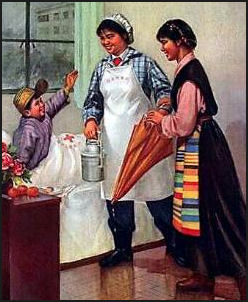
Chinese government
propaganda poster Ethnic minorities have traditionally settled disputes among themselves with the guidance of village elders rather through government judicial systems. Social control is often exerted through customary law and moral pressures. Violators of social norms are sometimes given harsh punishments.
Sometimes the traditional tribal customs of ethnic minorities are at odds with laws in the states and nations that govern over the minorities.
To varying degrees governments have made an effort to bring the hill tribes into the mainstream by giving them access to better medical care and educating them in village schools. The governments, the United Nations and various aid organizations have also been working hard in Southeast Asia to replace opium as a major source of income for hill tribes by encouraging the hill tribes to grow other cash crops such as coffee or beans, and finding markets for their colorful and distinctive crafts, jewelry and textiles.
The Eastern Tibet Training Center (EETI) is a vocational training school in Shangri-La (Zongdian) in Yunnan Province where Tibetans, Naxi, Bai, Han and Yi from rural villages are taught English, computer skills and other things in a 16-week, live-in, fully-funded program. The founder of the school, Ben Hillam, a professor at Australian Nation University specializing in development in China, told National Geographic, the school is designed to help students from rural areas bridge the gap to urban job opportunities...They are traditionally agropastorialists, experts at subsistence farming growing barley, raising yaks and pigs. But these aren t the skills that youth need today...Culture is something that constantly evolves...Economic development can rekindle interest in cultural heritage, which is inevitably reinterpreted.
See Separate Articles: MINORITIES IN SOUTHEAST ASIA AND SOUTH CHINA AND THEIR HISTORY factsanddetails.com ; LANGUAGE AND RELIGION OF MINORITIES IN SOUTHEAST ASIA AND SOUTH CHINA factsanddetails.com; LIFE AND CULTURE OF TRIBAL GROUPS IN SOUTHEAST ASIA AND SOUTH CHINA factsanddetails.com
RECOMMENDED BOOKS: Hill Tribes: “Hill Tribes: Lonely Planet Phrasebook” by David Bradley (2008) Amazon.com; “Lonely Planet Hill Tribes Phrasebook & Dictionary” by David Bradley , Christopher Court, et al. (2019) Amazon.com; “The Hill Tribes of Northern Thailand” by John R. Davies Amazon.com; “Lao Hill Tribes: Traditions and Patterns of Existence” by Stephen Mansfield Amazon.com; “The Hill Tribes of Thailand” (1989) Amazon.com; “The Hill Tribes of Thailand” by Mongkol Chanbamrung and Thaworn Foofuang (1995) Amazon.com “Mon-Khmer Peoples of the Mekong Region” by Ronald D.renard and Dr. Anchalee Singhanetra-Renard Amazon.com; “Lonely Planet Vietnam, Cambodia, Laos & Northern Thailand” by Greg Bloom, Austin Bush, et al. (20210 Amazon.com
Economy of Minorities in South China and Southeast Asia
Hill tribe people usually are among the poorest people in their countries. Traditionally they have had a very low standard of living. Most groups are self sufficient farmers. They are not known as being traders or peddlers. They get most products they need from state stores or markets. In most cases they trade or use money earned from the agriculture product they grow. They also sometimes collect forest products such as mushrooms, fruits and herbal medicines. Most trading is done between highlanders and lowlanders at markets held every week or four or five days.
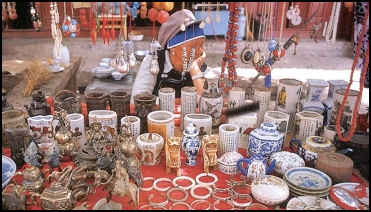
Naxi hawker
Some groups are known for producing blacksmiths, potters and peddlers and middlemen between the dominant ethnic group and minority peoples. Others produce produce batik, embroidery, sleeping mats and bamboo hat for sale and harvest local pine and fir trees for lumber. Some earn money from cross border trade and smuggling. Women sell crafts in towns and tourist spots. Opium has traditionally been the most lucrative cash crop and trade item.
Threads of Yunnan is an organization that brings finely handcrafted items to customers worldwide. It is a member of the International Fair Trade Association, which ensures that producers earn a fair wage, work in healthy conditions and women are treated equally.
Tourism and Trekking
Hill tribes are popular with tourists because of their fascinating and unique customs, styles of dress, architecture and crafts. Some tribes wear their traditional costumes all the time. Others only wear them during important festivals or events such as weddings and funerals. Yet others throw them on when tourists show up. Their festivals are often colorful and aspects of their daily life and religion are quite alien and interesting to Westerners.
Treks are offered by numerous groups in areas occupied by ethnic minorities.The treks range in length from one day to several weeks. The longer treks allow visitors to reach the most beautiful spots and unspoiled villages. Most travelers go on three-day-two-night treks or five-day-two-night treks.
A typical $50-per-person, three-day two-night trek begins with breakfast at a hotel, followed by a four-hour minibus ride to the trail head and a three or hour walk to the village, where the trekkers spend the night. One the second day the trekkers walk to a village, ride on elephants for a couple of hours, and walk some more to another village to spend the second night. The third day often features a raft ride on a river to the pick up point.
The nights are usually spent in hill tribe village huts and the meals are prepared by the villagers. Porters that accompany the trekkers carry anything that is heavy and most trekkers only carry a small day pack.
Agriculture
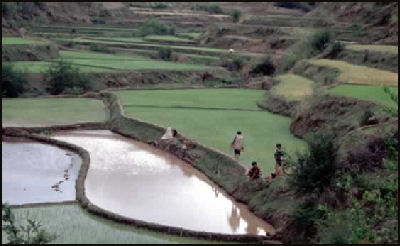
Yi rice field The lives of minorities are ruled by the rhythm of the agricultural seasons. The harvest is the most important time of the year. Transplanting rice is usually done in May or June. In the summer the dikes are repaired and the water flow into the paddies are regulated. The harvest is usually in November or December. Some groups grow wheat in the winter and spring and rice in the summer and fall. After the wheat is harvested the land has to be prepared for rice. Water buffalo are used as plow animals. Harvesting and threshing is still largely done by hand. Villagers working in the fields often prepare their meals and eat there.
In the old days when slash and burn agriculture was mainly practiced the forest and farm lands were collectively owned. Villagers help each other out. The community worked the land together and shared the harvest. Some tribes plant corn in swirls rather than rows, a practice that probably was conceived as a way of accommodating the irregular shaped mountain fields. To make corn flour, the kernels are crushed with a contraption that looks like a see saw. Having water for irrigation is important consideration for choosing a village site.
Many groups have traditionally grown rice and wheat in the plains and maize and buckwheat in the mountains. Lowland rice is grown during the wet season in paddies. Oranges and papayas are grown on the lower slopes of mountains and peaches and apples on the upper slopes. Dry-land rice is raised in slash-and-burn fields on slopes of mountains between elevations between 3,500 and 4,000 feet. It has a drier texture than white rice and is nourished completely with rain water. Vegetables such as pumpkins, cabbages, beans, greens, peppers and yams can be planted in the these rice fields. Maize, chiles and cotton are grown other fields. Opium has been an important cash crop. Other cash crops include grown include tea, sugar cane, cotton, ramie, hemp, cocoa, tung trees, coffee, bananas, silk, ramie, rape, tobacco, peanuts, flax, walnuts, Chinese chestnuts, pears, oranges and tangerines.
Pigs are raised for consumption. Other domesticated animals include oxen, horses, mules, sheep, donkeys, chicken, ducks, goats, cattle and water buffalo. Fodder for pigs and chickens is concocted from things like corn husks, banana stalks and squash.
Slash and Burn Agriculture and Terraces
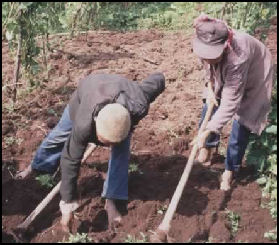
Yi working a field by hand
Many hill tribe members are subsistence slash and burn agriculturists. Following ancient traditions that go back thousands of years, they torch their fields and burn down trees after the harvest and before the planting season to claim new agricultural land, fertilize the soil and get rid of insects. This method of agriculture has many detrimental environmental affects. It pollutes the air, erodes and degrades the soil, destroys the forest, and dries up springs. Scientists have shown that field fertilized with the manure from grazing water buffalo and left fallow for a period of time are more productive than those burned off.
Slash-and-burn agriculturalists generally only produce one crop a year (wet rice farmer typically have two or even three crops). The fields are prepared in March, planted before the summer monsoons and harvested in October. Rice liquor is often spit onto the flames of fire to help it get going and spread, and firebreaks are cut to prevent the fire from spreading into the forest. Teak forests usually are not cut for crops, because the sandy soil in which teak grows best it not good for agriculture.
Hundreds of square miles of forest are slashed and burned in China and Southeast Asia every year. Conservationist have estimated that the amount of timber lost on each acre is often worth twenty times the value of the rice grown on it. Slash-and-burn farming is a sustainable form of agriculture if the land is left fallow for at least seven years after a harvest. But this rarely happens, especially now that rising populations have forced hill tribes to cultivate the land every year with expensive fertilizers replacing the nutrients depleted from the soil by overfarming. Sometimes the agricultural land is not cultivated if a bad omen has been received.
Some practice terraced rice farming. Wet rice is grown in the terraces and dry rice and other crops are grown on slopes that have been slashed and burned. In hilly and mountainous areas around the world, terraces are widely used to make slopes into arable land. Terraces conserve soil and prevent erosion but their primary purpose is to create flat land that retains water rather than letting it trickle away. Temporary dams direct the flow of water. Dirt and water are kept in place with earth or earth-and-rock ridges, or dikes, that are constructed at a standard height of around 15 inches and are wide enough for people can walk on them.
See Separate Article SLASH-AND-BURN AGRICULTURE factsanddetails.com ; See Terraces Under AGRICULTURE IN THE DEVELOPING WORLD (THIRD WORLD) factsanddetails.com
Opium Farming
Many of the hill tribes have traditionally produced opium as their main source of income. Chinese traders introduced opium to ethnic minorities in Southeast Asia. One forth of the money the French earned in Southeast Asia was generated from opium. The French gave poppy seeds to ethnic minorities in Laos, and gave them advise on how to increase their opium yields. At one point about 90 percent of the Laos's total opium output was produced by the Hmong (Miao).
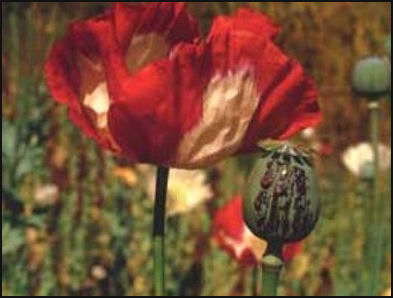 Many minorities live in villages located at 3,000 to 6,000 feet, an altitude perfect for growing opium poppies. Opium and corn are often grown together. Opium is planted in September or October and harvested after the New Year. Corn is planted in May or June and harvested in August or September before opium is planted. Opium grows well in poor soils. Before planting Miao farmers taste the soil. If it is sweet (meaning its has a high lime content) then the soil is ideal for growing opium. During planting men march along poking holes in the soils with a dibble stick while women and children follow behind sowing seeds.
Many minorities live in villages located at 3,000 to 6,000 feet, an altitude perfect for growing opium poppies. Opium and corn are often grown together. Opium is planted in September or October and harvested after the New Year. Corn is planted in May or June and harvested in August or September before opium is planted. Opium grows well in poor soils. Before planting Miao farmers taste the soil. If it is sweet (meaning its has a high lime content) then the soil is ideal for growing opium. During planting men march along poking holes in the soils with a dibble stick while women and children follow behind sowing seeds.
Some blame the degradation of the soil by slash and burn agriculture on opium. Slash and burn farming techniques used to raise opium have caused heavy deforestation, severe soil erosion, and other environmental problems. Opium depletes the soil quickly, and consequently many of the tribes were nomadic or semi-nomadic — settling on one area to raise an opium crop and then moving on to a new place once the soil was worn out.
The Yao, Miao, Hani, Lahu and Lisu have traditionally grown rice to eat and opium for medicine and money. Profits are used to buy jewelry, silver bars, rifles, radios, pigs and buffalos. The social costs of opium cultivation include addiction and a lazy-spaced out population. Opium toleration policies in Thailand have ended. There the Hmong and other groups have been encouraged to grow alternative cash crops.
The Wa, a fierce group of former-head-hunters, now controls some of the major opium growing areas in Myanmar. Karen farmers are known for growing opium but no consuming it. The Lisus, Hani and Miao have traditionally been among the Golden Triangle's largest opium-producing tribes. In some Miao villages men don't do much except sit around the village and get drunk or smoke opium. Hani women are known as being hard workers while men waste away much of their life smoking opium.
Hunting and the Environment
Many groups still hunt. Traditional hill tribe tools and weapons such as knives and crossbows are sometimes made in village smelters hot enough to melt iron and stoked with bellows that works like a bicycle pump. Fishing is done with traps, nets, poisons and explosives mostly for consumption.
Many tribes used to use crossbows with bamboo arrows which are capable of hitting a target the size of a playing card at a distance of 50 feet. Miao hunters are supposed to wipe their crossbows with the blood of the animals they kill to appease trail spirits which cause sprained ankles and other injuries.
Rifles of various kinds, sometimes flintlock muskets, have replaced traditional cross bows. Most game is caught with traps and snares. Hunters used to catch deer, wild boars, bamboo gopher and jungle foul but many of these animals are gone due to overhunting. Squirrels and frogs are trapped with trip string nooses. Bats, rats and lizards are considered delicacies by many tribes.

Yi planting rice
Hill tribes cause a lot of deforestation through slash and burn agriculture (See Agriculture Above. In some parts of Southeast Asia, when the forests and fields are set blaze before the planting season there is so much smoke in the atmosphere that weather-monitoring satellites sometimes mistake the smoke for clouds from major weather disturbances. In some places the effort to slow deforestation includes relocating slash and burn agriculturists to lower elevations near water supplies. Many hill tribes have resisted such moves.
Image Sources: Landsberger Posters, San Francisco Museum, CNTO, Yi VPO website
Text Sources: New York Times, Washington Post, Los Angeles Times, Times of London, National Geographic, The New Yorker, Time, Newsweek, Reuters, AP, Lonely Planet Guides, Compton s Encyclopedia and various books and other publications.
Last updated October 2022
